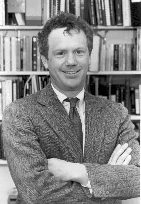5th Kaczmarczik Lecture
"A Runaway Universe? Supernovae and the Cosmological Constant"
Robert P. Kirshner
Harvard-Smithsonian Center for Astrophysics
Thursday, February 23, 2000
3:30 p.m.
Main Building Auditorium
3141 Chestnut Street
Philadelphia, PA 19104
Supernovae are exploding stars that are bright enough to observe halfway across the Universe. Using supernovae as distance indicators, astronomers can now investigate the history of cosmic expansion. Our latest results indicate that the Universe is not being decelerated in the way we expected, based on the observed amount of matter in the Universe. Instead of measuring the predicted slowing down of cosmic expansion, the supernova evidence favors cosmic acceleration over the last 8 billion years.
If this new picture is correct, it predicts the Universe will expand at an increasing rate as time goes by, a "Runaway Universe." The observed acceleration requires most of the energy density of the Universe to reside in the form of a Cosmological Constant as presciently suggested by Einstein in 1917. This talk will present the evidence for this strange new picture of the Universe.
 Robert P. Kirshner is Professor of Astronomy at Harvard University and an Associate Director of the Harvard-Smithsonian Center for Astrophysics. He graduated from Harvard College in 1970 and received a PhD in astronomy at Caltech four years later. After a postdoc at Kitt Peak National Observatory in Tucson, he joined the faculty at the University of Michigan for 9 years before moving to the Harvard Astronomy Department in 1986. He served as Chairman of the department from 1990-1997.
Robert P. Kirshner is Professor of Astronomy at Harvard University and an Associate Director of the Harvard-Smithsonian Center for Astrophysics. He graduated from Harvard College in 1970 and received a PhD in astronomy at Caltech four years later. After a postdoc at Kitt Peak National Observatory in Tucson, he joined the faculty at the University of Michigan for 9 years before moving to the Harvard Astronomy Department in 1986. He served as Chairman of the department from 1990-1997.
Professor Kirshner is an author of over 200 research papers dealing with supernovae, the large-scale distribution of galaxies, and the size and shape of the Universe. His recent work on the acceleration of the Universe was dubbed the "Science Breakthrough of the Year for 1998" by Science Magazine. He was elected to the National Academy of Sciences in 1998.
Kirshner is a frequent public lecturer on science, including the 1997 Princeton University lectures, the 1998 Seyfert Lecture at Vanderbilt University, and a featured talk to the National Science Teachers Association at their national meeting in 1999. He is also the teacher of Science A-35, a core curriculum course for 250 Harvard undergraduates entitled "Matter in the Universe." The vivid (and slightly hazardous) demonstrations in Science A-35 led to Kirshner's being featured in Boston Magazine in their October 1998 article on "Nutty Professors".
High School Open House Program:
12:30 - 1:00 p.m. Main Building Auditorium
1:00 - 3:00 p.m. Department of Physics Open House
Brief presentations on Biophysics, Astrophysics, Computational Physics, Condensed Matter, Nonlinear Dynamics, Particle Physics, etc. An excellent opportunity for high school students to visit our laboratories and meet in person with our internationally recognized researchers.
3:00 - 3:30 p.m. Reception
About the Kaczmarczik Lecture
Paul Kaczmarczik began his career as a Professor of Physics at Drexel University in 1953. A key player in building the Physics and Atmospheric Science Department, he made important contributions to teaching at Drexel University during his many years of service. Well-liked by both his colleagues and his students, Professor Kaczmarczik became Professor Emeritus in 1989. The Kaczmarczik Lecture Series was established in 1995 in honor of Professor Kaczmarczik. It brings to Drexel outstanding scientists to present lectures on topics at the cutting edge of Physics research.